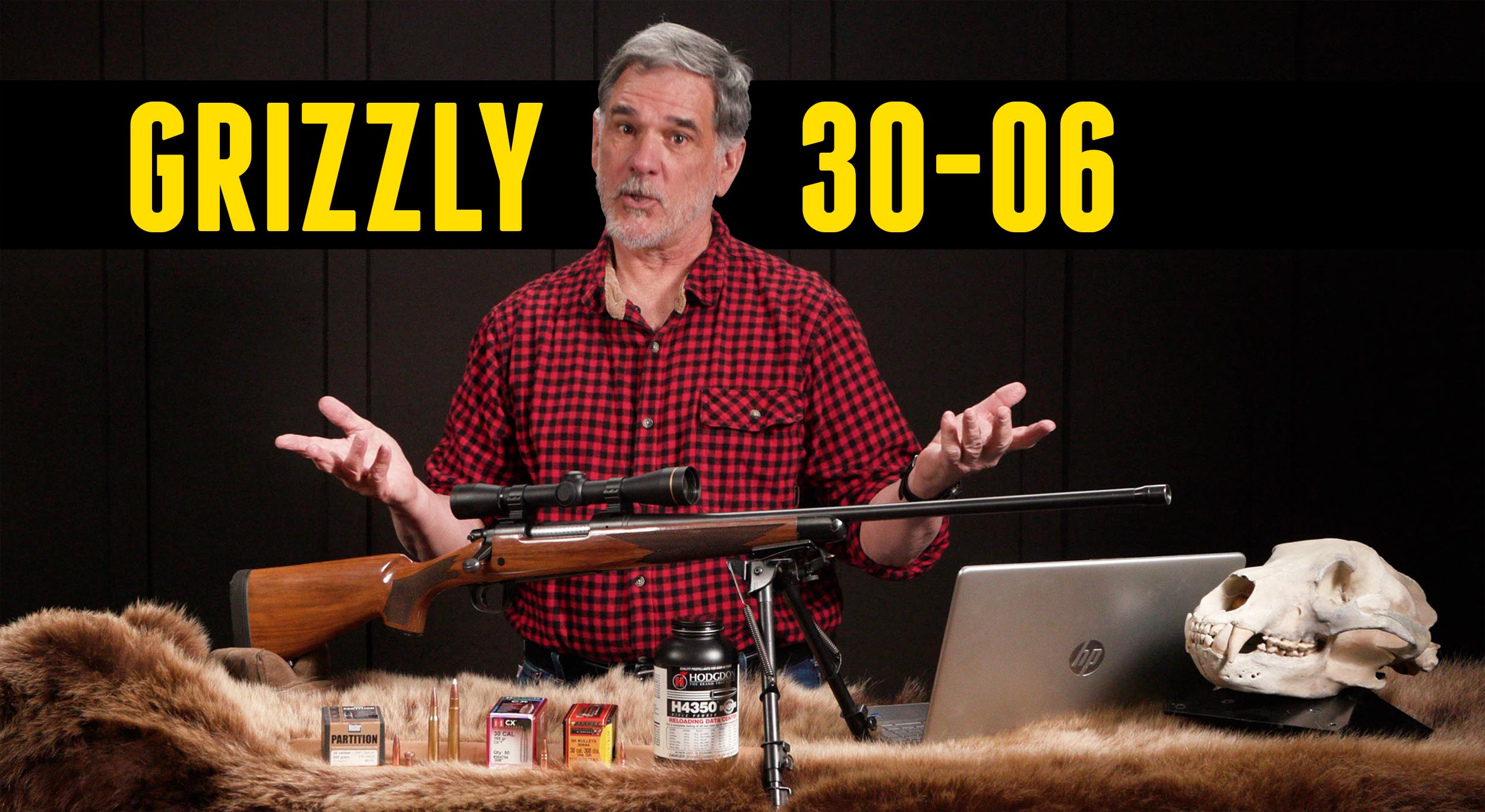I had long wanted to hunt grizzly in Alaska, and finally saved enough to pay for the hunt. There’s a lot to consider when contemplating a grizzly hunt, from the gun to the cartridge, terrain, and location!
Disclaimer
Ultimate Reloader LLC / Making with Metal Disclaimer: (by reading this article and/or watching video content you accept these terms). The content on this website (including videos, articles, ammunition reloading data, technical articles, gunsmithing and other information) is for demonstration purposes only. Do not attempt any of the processes or procedures shown or described on this website. All gunsmithing procedures should be carried out by a qualified and licensed gunsmith at their own risk. Do not attempt to repair or modify any firearms based on information on this website. Ultimate Reloader, LLC and Making With Metal can not be held liable for property or personal damage due to viewers/readers of this website performing activities, procedures, techniques, or practices described in whole or part on this website. By accepting these terms, you agree that you alone are solely responsible for your own safety and property as it pertains to activities, procedures, techniques, or practices described in whole or part on this website.
Are All Grizzlies the Same?
Bears are known by many different names depending on their location: grizzly, Alaskan brown bear, Kodiak bear, silvertip and more. When Lewis and Clark first encountered grizzlies they called them “white bear” as opposed to the black bears they had known in eastern North America. Size-wise, coastal bears and those on the islands off the coast of Alaska grow to huge proportions due to a milder coastal climate and an abundance of salmon upon which to feed. Further inland and perhaps farther north, the same species of bear does not reach the same size.

After talking with several different Alaskan bear guides, I decided to pursue the inland bear, usually referred to as the grizzly. These bears have a longer hibernation and their food supply is not as abundant. Many are active hunters and they often have particularly striking hides. Some have said that a grizzly is built like a tank. Grizzlies are big, very strong, fast, and can be aggressive. Grizzlies generally weigh approximately 600 lbs. and stand 8 feet tall, though they can be smaller or larger.
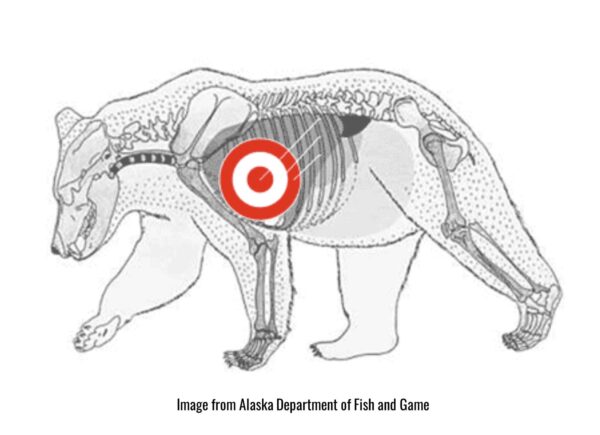
Just as deer are scored by antlers, bears are officially scored by skull size for the record book. An unofficial but often used measurement is the “square” of the bear skin measured from the tip of the nose to the tail, plus the width from one outstretched front paw to the other. Weights are usually estimated as getting the entire carcass out of the wilderness to a set of scales is unrealistic. For reference, the black bears I’ve taken in Washington had skulls in the 18 inch range, squared about 6 feet, and estimated weights between 300 and 340 lbs. (males).
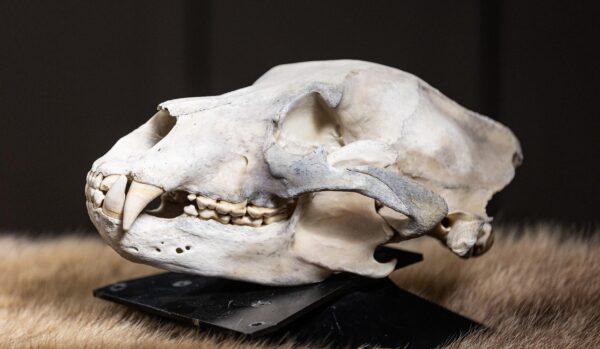
Though we often talk about the size of the grizzly, they’re not just big, they are truly dangerous game. The great bears— brown, grizzly, and polar bears— are truly at the top of the food chain in North America, and much of the northern world.
Typical Grizzly Cartridges and Considerations
The great bears have been taken with a wide variety of firearms but most common are the .300 Win Mag, .338 Win Mag and .375 magnums. Surprising to many is that the .30-06 has also had a long and successful history as a very capable grizzly cartridge. I was very interested in which cartridge and bullet my outfitter and guide Lyle Becker would recommend. Lyle is an experienced Alaskan big game guide who has been on many hunts. He’s also very knowledgeable about hunting rifles and ammunition, often doing his own gunsmithing and handloading. I asked him which of my rifles he’d recommend for the hunt. He responded with two questions.
- This is rugged country—hiking is difficult. Which rifle weighs less?
- This is open country, a 300-yard shot may be necessary. Which rifle do you shoot best?
We spent a fair bit of time on the phone discussing the conditions I should prepare for. The shot could be at very close range or it could be out to 300 yards. Shooting an unwounded grizzly beyond 300 yards is not advised! There is too much that can go wrong and too much riding on that shot being effective. A wounded grizzly can cover a lot of ground in a hurry and might make it to thick cover — requiring a dangerous follow-up stalk.
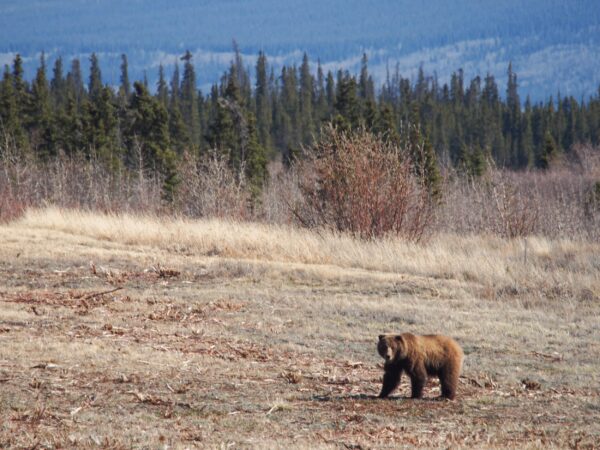
The weight of the rifle is another important consideration. A heavier rifle tends to be easier to shoot well but a lighter rifle may be faster to get into action and easier to pack across rough country.
The power of the cartridge, design of the stock, and weight of the rifle all contribute to the shootability of the rifle. It’s simply more difficult to shoot a hard-kicking rifle well and rifles generally kick more with less weight.
Choosing a Rifle
I had two rifles in my gun safe that I considered possible candidates for this hunt: a wonderful custom-built .375 H&H Winchester Model 70 and a .30-06 Remington 700 CDL. How to choose between them?
For those who aren’t familiar with the .375 H&H, it might be surprising to note that the trajectory is quite similar to that of the .308 Winchester and .30-06 cartridges. Bullets of similar ballistic coefficients can be used and the muzzle velocity isn’t much different. My first big game kill with the .375 H&H was a one-shot bear hunt in Washington. I took the bear cleanly at just over 300 yards, no problem. My .375 H&H Winchester Model 70 set up sends at 300 grain bullet at 2,550 fps and a 260-270 grain bullet at 2,700 fps. In comparison, my .30-06 Remington 700 CDL sends a 200 grain bullet at 2,600 fps and a 165 grain mono at 2,900 fps. Trajectory was simply not a point of contention between the two rifles.
Obviously the .375 H&H throws a bigger, heavier bullet and produces considerably more power than the .30-06 cartridge. It also kicks harder, though not terribly so. My particular .375 H&H weighed quite a bit more than the .30-06 as well, making it harder to carry over rough terrain. Both had very similar optics – the .375 H&H sporting both sights and a QD 1.5-5x Leupold. The .30-06 has a 2-7x Redfield installed.
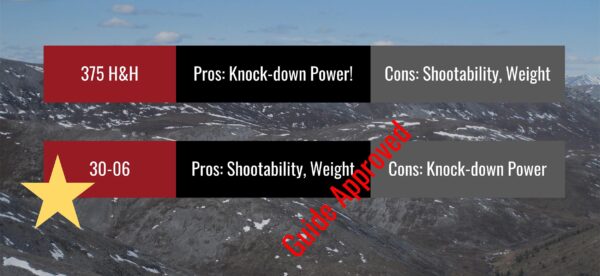
I considered Lyle’s earlier questions and decided on the .30-06. It is lighter, handier, easier to carry and I shoot it somewhat better than I shoot the .375. I also had far more experience afield with the .30-06, having taken elk, black bear, mule deer and pronghorn antelope with it out to 300 yards.
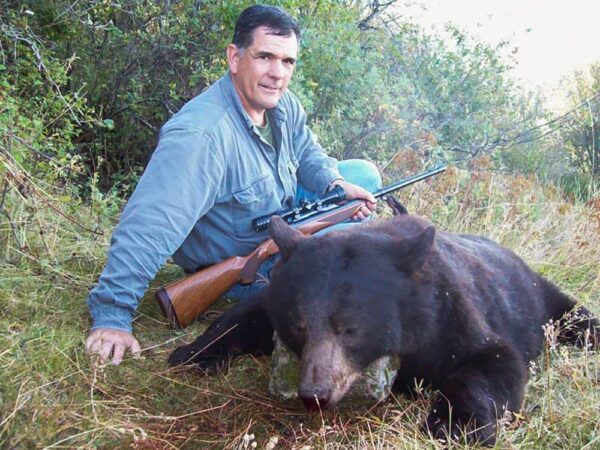
Lyle told me that if we’d been hunting the big coastal brown bear, he’d have nudged me towards the .375 H&H, but also said that neither rifle would be a mistake. He did urge me to load premium bullets, either heavy Nosler Partitions or the all copper Barnes TSX. Depending on the shot angle, reaching the vitals of a grizzly could require deep penetration.
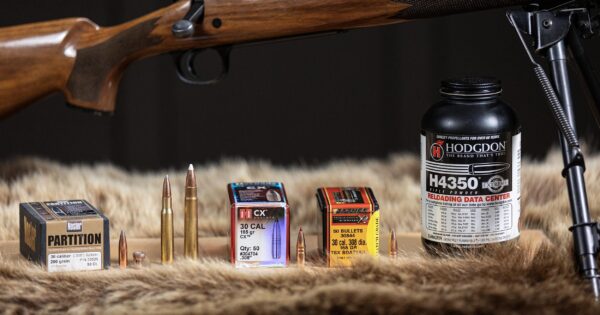
I’d also spoken with perhaps the most famous of present-day Alaskan brown bear guides: Phil Shoemaker. He also helped me realize that I was more interested in hunting the interior grizzly. I’d spent some time on the coast, but had never hunted or fished the Alaskan interior. Phil has been guiding big game hunters in Alaska for decades and has some strong thoughts on rifle, cartridge, and bullet selection. He often uses a .458 Winchester Magnum when he is guiding a hunter, figuring that if he needs to shoot, it may well be to stop a close range charge. For hunting them though, he urges his clients to hunt with a rifle they’re familiar with, and has absolutely no problem with the .30-06 as a suitable grizzly/brown bear cartridge. He too is an advocate of using deep-penetrating premium bullets for the big bears.
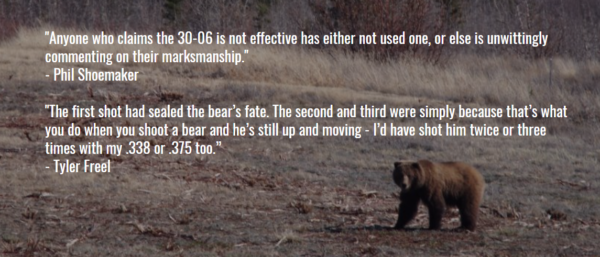
Much later, years after the hunt, I was intrigued to read an article by Tyler Freel, another writer who has had the opportunity to hunt grizzly every year. He had deliberately selected a 6.5 Creedmoor for his grizzly hunt. I’m sure this surprises some readers, but Tyler knows grizzlies. He’s taken them with a traditional muzzleloader shooting a soft lead ball, as well as with traditional archery gear, including using a stone-tipped arrow! Tyler did work up his 6.5 Creedmoor load with the well regarded 140 grain Nosler Partition bullets. After swapping thoughts with Tyler, my .30-06 seemed like a cannon in comparison.
The Load
Unlike Tyler Freel and Phil Shoemaker, I don’t get to hunt grizzly often. I suspected that this hunt would be my only grizzly hunt and I wanted to make sure that I was well prepared. I was 61 years old at the time of the hunt, and in pretty fair shape thanks to cycling, hiking, and strength training. I did increase the duration and intensity of all my workouts leading up to the hunt. I didn’t want to be the old hunter who couldn’t keep up with the guide or who couldn’t climb some hill necessary for success.
Quality clothing was a must. Lyle had quite specific hip boots, Gore-Tex, fleece and more. He knows what works for the Brooks Range on a spring bear hunt. I took the opportunity to upgrade my hunting gear. This hunt was in a time of ammunition and handloading component shortages. I had the 165 grain Barnes TSX and Nosler Partitions available in both 200 and 220 grain weights. I selected the 200 grain Partition and H4350 powder.

This 2600 fps load reliably grouped about an inch at 100 yards time after time. H4831 would likely have given me another 75 to 100 fps, but I had far less of it available and couldn’t find more on the shelves of the local shops. H4350 has long been a favorite .30-06 powder of mine and I was extremely comfortable with it. The load was also surprisingly easy to shoot. The Remington handled it well and I wasn’t uncomfortable using it. I zeroed the gun at 200 yards and had no problem consistently ringing a 300-yard gong. For hunting ammunition, particularly for dangerous game, it’s crucial that the ammo cycles with 100% reliability through the action. Reliability of the ammunition is more important than match-winning accuracy for hunting. Be careful with seating depth and full-length size your cases. After establishing my load and zero, I quickly moved off the bench and into training from field positions: prone, sitting, kneeling, and standing. Away from the rifle range, I set up a steel target in a canyon, then went to the bottom of the canyon and slowly stalked forward, uphill.
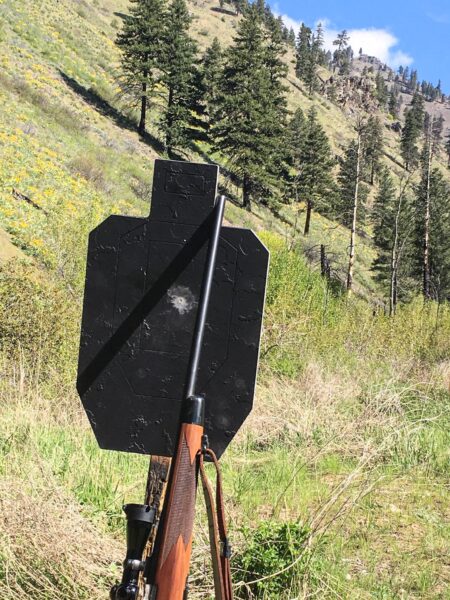
Every time I’d see the steel target, I’d shoot it at least once, usually a couple of times, before reloading the rifle in a hurry. I shot from sitting, kneeling, and standing during this exercise. Prone was too low and I couldn’t usually see the target because of intervening grass, brush, and fallen trees. I’ve always enjoyed training with hunting rifles in such a manner and believe that this method has rewarded me many times in the field.
The Hunt
We flew north from Fairbanks in a very interesting aircraft, a Helio Courier. This plane was developed for the CIA during the Vietnam War and has quite a range. It’s big enough for a pilot, two passengers, and a fair bit of gear. We eventually landed at a remote gravel bar and unloaded. The pilot quickly turned the plane around and soon was airborne again, flying south for the other guide, Joey Klutsch, and another hunter (Jim). There was an awesome quiet after the sound of the plane faded. We were likely the only humans for a hundred miles!
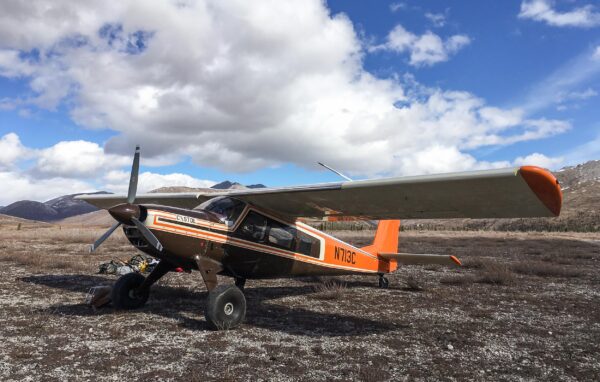
Lyle and I began ferrying gear across a small stream and setting up camp. We had a cook tent and four small, backpacking-type tents with some low cots—one for each of us. In due time, the plane returned along with the other two fellows who would be in camp and their gear.

I was particularly interested in the rifles and ammunition everyone had brought along. Lyle had his battered wood-stocked Remington 700 in .375 H&H with handloaded 260 grain Nosler Accubond bullets. Joey brought his synthetic-stocked Sako in .338 Win Mag with 225 grain Barnes TSX ammo. I had my Remington 700 CDL with 200 grain Nosler Partition handloads and Jim had a Browning bolt action in 7mm Remington Magnum with Barnes TSX ammo.
Lyle and Joey explained that they had just come from a month of guiding bear hunters on Kodiak, which is why they were still packing larger caliber rifles. We set up a target at about 100 yards and took a few shots at it, confirming our zeros. This was also an opportunity for the guides to see how well we handled our hunting rifles. There were no issues.
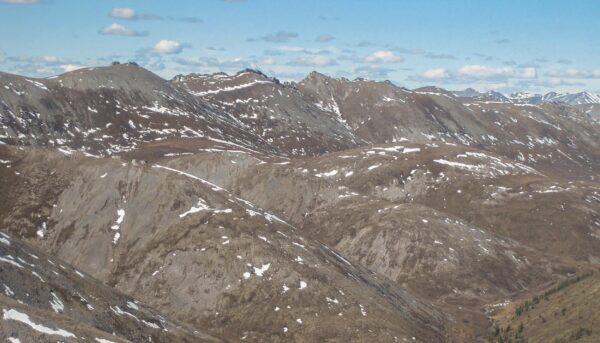
We quickly settled into a routine. We’d be hunting primarily by observing from a small knoll just above camp. The idea was to minimize hiking around the area and spreading our scent. I was glad that I had my Zeiss 10x binoculars, but the real work of spotting was done by Lyle and Joey with their spotting scopes, a Leica and a large Swarovski. The sun never really set during the nine days of this hunt. It dipped towards the horizon around midnight, but there was no real darkness. We tried to keep at least one or two of us up on the knoll glassing for bear most of the time.
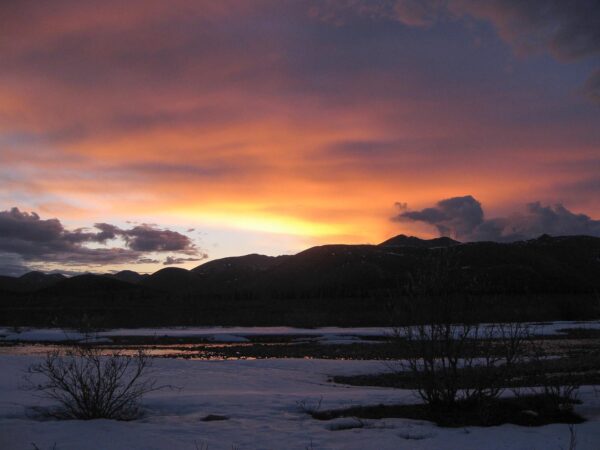
Everyday, there was either rain or a bit of light snow. Temps remained mostly in the 20’s and 30’s. Occasionally the wind would slow or stop, the temperature would warm, and Alaska’s famous mosquitoes let us know that they are truly the apex predator of the north! I learned to treasure the colder temps and wind that kept the mosquitoes away. Herds of caribou passed through the area and were quite interesting to watch. An occasional wolf trotted by as well, typically giving us a wide berth. I saw one arctic fox hunting for small game along a nearby creek. Ptarmigan were frequently seen, and late in the trip several marsh hawks made their appearance. Bears however, were few and far between.
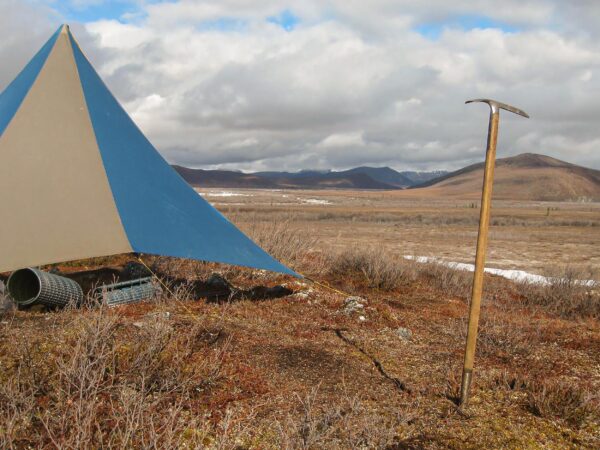
Finally, a small, blonde-colored grizzly came past camp. Lyle and I attempted to set up for a possible shot, but she sped up and left us far behind. A couple of days later, it was Jim’s turn to stalk a grizzly. He and Lyle set out to intercept one in the flats below our camp. I watched the stalk through my binoculars with excitement as the two men and the grizzly drew closer together. When he was 80 yards away, Jim took a prone shot with his 7mm Rem Mag and quickly dropped the grizzly! Joey and I hurried down to help with the photographs and the skinning. It was a beautiful boar, squaring a bit over 6’ which is typical for the arctic/interior grizzlies. Jim was ecstatic, this being his third grizzly hunt and the only time he’d gotten a shot at one! The mood in camp that night was jovial with many smiles.
We summoned the plane via satcom and it arrived a day or so later, taking Jim, Lyle, their gear, and the grizzly. Camp was much quieter then. Joey and I kept up the routine: glassing, seldom moving from camp, and waiting for another bear. By the seventh day, caribou had ceased to visit and even wolves seemed scarce. With only two days left to hunt, I began to think I might go home without a bear.
It was late in the day when Joey quietly muttered “bear.” I took a look through the Swarovski spotting scope and watched the bear for a bit. He had the big, blocky look of a mature bear and was headed roughly in our direction, though at least a mile out. We quickly shed our warmest layers, taking only what we’d need, and jogged down the hill. We then crossed a thigh-deep stream and emerged onto a snow- and ice-covered willow flat. Visibility was less than 100 yards due to the willows. We each chambered a cartridge, double-checked that the rifles were on safe, and slowly moved forward together. Joey was watching ahead and left, I was watching ahead and right. I feared that the grizzly would pass us in the willows without us seeing him.

Suddenly Joey whispered “Don’t move.” I froze and slowly looked to the left. There he was. The bear was coming out from behind a small tree no more than 50 yards away. I rushed my first shot and I’m sad to say I sent it sailing over the bear’s back. I instantly worked the bolt and chambered a second round. The bear didn’t break stride but swerved towards us, exposing his right flank. I shot again, dropping him! The bear rolled and was up again in a flash! Our goal was to prevent him from getting into the thick willows. We both fired, and with the last shot in my rifle I dropped him again. The bear was now about 15 or 20 yards away, and down for good, but not done. I began to reload my rifle but Joey handed me his .338 and I finished the bear with that. Those few seconds of shooting and moving were an amazing end to the hunt.

It was now past midnight, and getting colder. We took some photos of the mighty bear, then set about skinning him and moving back to camp. Our progress was slow, the hide was heavy and camp was uphill. We reached camp at about three in the morning, enjoyed a celebratory drink, and crawled into our sleeping bags, exhausted. The next day we called for the plane and spent the next two days fleshing out the hide and skull, taking some photos and packing up camp. The hide squared a few inches over eight feet with a 21” skull — an impressive size for the arctic/interior grizzly. It narrowly missed Boone & Crockett designation.

Afterthoughts
Any hunt comes with risks and what if’s. So, what could have gone wrong? We might not have seen the grizzly or missed the bear in the willows. A slow and careful approach helped as well as many hours of glassing. I also could have only wounded the grizzly. This would have likely resulted in a dangerous tracking job in the willows. Fortunately I was able to drop him, twice, and he stayed down the second time.
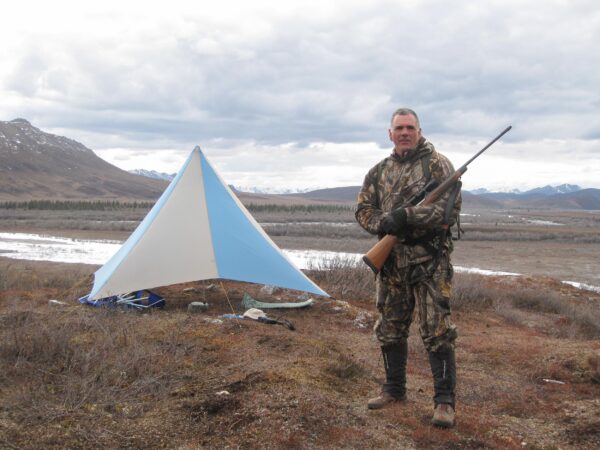
This was an incredible hunt, likely a once-in-a-lifetime experience for me. I’ve thought about the entire hunt, particularly the fast-paced shooting at the end, many times. Sometimes I think that I’d have liked to have had the. 375 H&H Winchester Model 70 or even my stout-loaded .45-70 Marlin lever action. Then again, I was far more familiar with the .30-06 Remington and didn’t feel under-gunned. I certainly could have shot better. One miss, one poor hit, and two good hits with the .30-06 rifle. I’d like to say that I coolly placed one shot, instantly dropping the bear, but that’s not what happened. I am glad that I practiced not only accurate shooting, but fast-paced shooting as well.
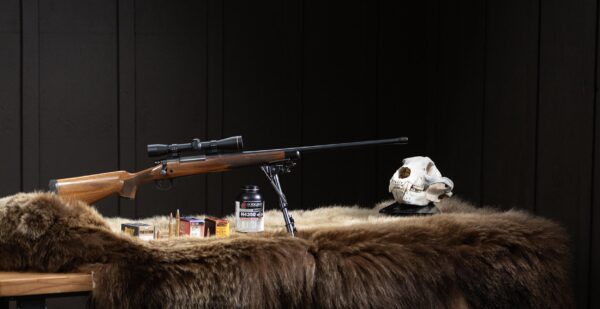
Would the .375 have dropped the bear more decisively? Quite possibly. It shoots a bigger, heavier bullet and produces considerably more power. It may have penetrated deeper and finished things with that first hit.
Conclusion
As I look back on that hunt, I don’t think that there’s anything wrong with choosing a larger, more powerful cartridge IF the hunter can handle it well. The .375 H&H, .375 Ruger, .338 Win Mag, and .300 Win Mag have all earned their reputation as excellent choices. Most of us likely find it easier to make good hits when we’re not fighting the recoil of a heavier-kicking rifle. I had great confidence in my .30-06 knowing that I’d handled it well on quite a few big game hunts prior to this. I hadn’t hunted with that Winchester Model 70 at all, so I was apprehensive.
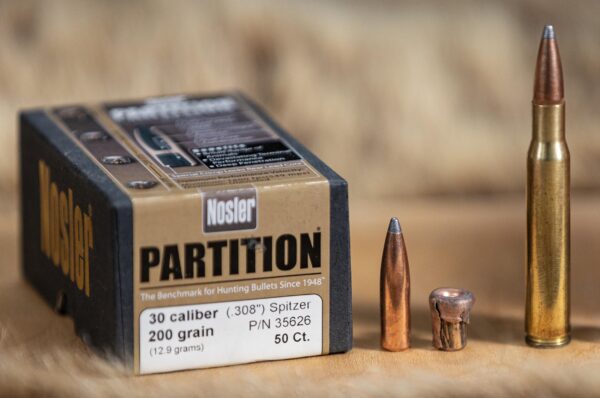
I used Nosler’s famous Partition bullet, and finished the bear with a Barnes TSX bullet from Joey’s .338 Win mag. The recovered Partition weighed 116 grains and had shed the front half of the bullet. We found the rear part of the bullet just under the off-side hide— it had penetrated nearly the entire width of the bear, but had not exited. Rapid expansion of the front and deep penetration by the rear of the bullet is typical of the Nosler Partition.
Other manufacturers offer deep-penetrating bullets that have also earned great reputations on big game including the Barnes TSX, Hornady GMX and CX, and the Swift A-Frame.
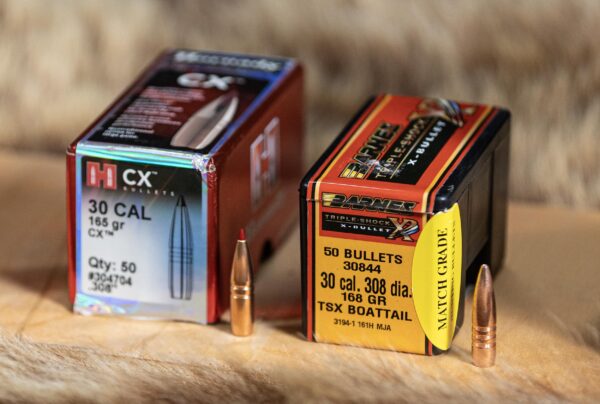
I liked everything about the experience and about how my gear worked. I stayed dry and warm and my rifle never faltered. Looking back, it would have been an excellent idea to use a more weather-resistant rifle, but a daily wipe down with a silicone cloth kept the rifle from rusting at all. Remington’s stock finish seems impervious to rain and snow as well.
Get the Gear, Make the Contacts
A guide is required for a non-resident to hunt grizzly/brown bear in Alaska. Honestly I think that’s a great idea anyway.
Lyle Becker: Guided Wilderness Hunts Brooks Range & Alaska Peninsula
Joey Klutsch: Alaska Guided Hunting Trips with Guides Joe & Joey Klutsch
Nosler .30 Caliber .308 Diameter 200 Grain Spitzer Partition Bullets at Midsouth Shooters Supply
Hornady .30 Caliber .308 Diameter 165 Grain CX Bullets
Hodgdon H4350 Smokeless Gun Powder at Midsouth Shooters Supply
CCI #200 Large Rifle Primers at Midsouth Shooters Supply
Hornady .30-06 Springfield Unprimed Rifle Brass at Midsouth Shooters Supply
Don’t miss out on Ultimate Reloader updates, make sure you’re subscribed!
Thanks,
Guy Miner
